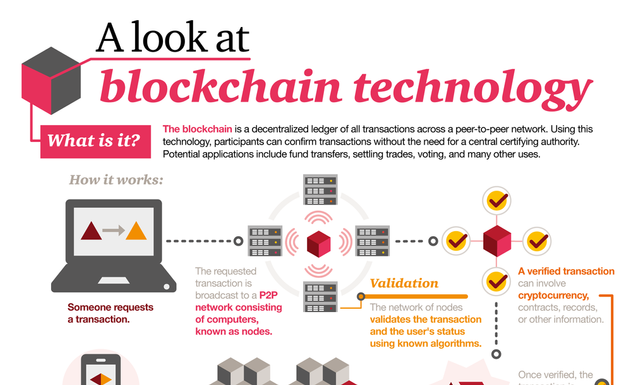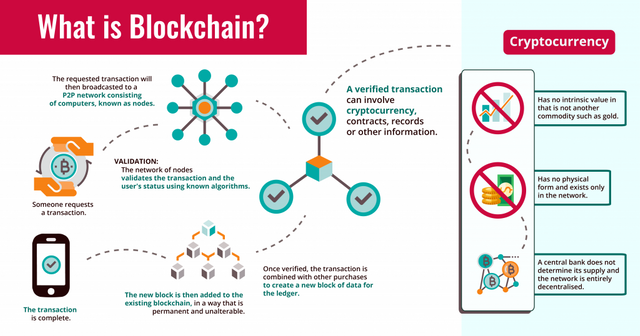How Does Blockchain Work Simply Explained
Well, let's start with the basics. Before you jump into the process, you need to take note of these critical features of blockchain.
Blockchains store any kind of data exchange on the platform. So, it’s like a ledger system, where every data exchange has a spot in the log. More so, the data exchanges in the system are called transactions. Once the transaction is verified, it gets a place in the ledger system as a block.
Once it's been recorded on the ledger, it can't be deleted or changed.
In reality, blockchain uses a peer-to-peer distributed network, which ensures its decentralized nature. Every device that connects to the network is considered a node. In order to understand how blockchain works, you need to understand the concept of “key.”
Technology itself is the basis for this. Keys are also integral to making your network secure, so a user will generate key pairs that are private & public to be put on the network.
Actually, there is a site called KeyMe which will cut you a key for $10. They'll send someone out to your location and have it ready that same day. It's great for contractors who need multiple sets of keys.
Anyhow, you’ll have to store the private key in a secure place because you’ll use this key to sign or perform any action on the network. On the other hand, other users will use your public key to find you on the system.
For example, imagine your public key as your bank account and private key as your signature that you can use to send or withdraw money. That’s why it’s necessary for you to keep the key as safe as possible.
In reality, if anyone gets access to your private key, they can easily misuse all your assets on the network.
How Does Blockchain Work: The Process
Firstly, a user or node will initiate a transaction and sign it with their private key. The private key will generate a unique digital signature that can't be altered.In reality, if anyone tries to modify the transaction information, the digital signature will change drastically, and no one will be able to verify it. Therefore, it will be dismissed.
Once this transaction is verified, it will be broadcasted to the nodes after that. Within the blockchain platforms' different methods of verifying transactions, they'll then use algorithms to confirm its validity. These are called consensus algorithms.
Anyhow, once it's verified as genuine, the transaction will get a place in the ledger. The ID and timestamp should make alteration unlikely.
It works in a way that the first block will link to the next block, and this will go on until a new block links up with this one, which creates a chain. It's called blockchain because these blocks are being linked together like chains.
How Secure Is The Technology?
Now, you know how blockchain works but are worried about security. Well, no network on the internet is 'unhackable' but blockchain does offer the highest level of security..
Blockchain works in a different method, not like the traditional centralized system. So, if you want to hack it, you would have to hack all the devices connected to it. Obviously, it’s a loss project and quite complicated, and that’s why it’s secured.
In reality, hackers would need a tremendous amount of resources to hack a blockchain platform, which will eventually be more costly than the gain itself.
Let’s move on to the next part in this how does blockchain work guide.
How Does Blockchain Consensus Work
You already know by now that consensus is a method of reaching an agreement. Basically, it’s a form of how individuals on the network can reach a resolution even though minorities may not like it.
In reality, the consensus is one of the core priorities of a blockchain because, without it, thousands of nodes can never come to an agreement. These models exist to create fairness and equality among all the participants.
However, there’s no one way to reach a consensus within a system. In reality, there are lots of algorithms that various blockchain platforms use. Obviously, every single one of them works differently and comes with its own set of flaws.
So, if you are wondering how does blockchain consensus work, you have to know about each one of them separately to understand.
Proof of Work
It’s one of the popular and first consensus algorithms introduced in the blockchain. Here, nodes are called miners, and they will solve complex mathematical issues with help from their device’s computational power to verify the blocks.
Can Blockchain Work Without Cryptocurrency?
Blockchain has been associated with cryptocurrencies for many years now. That's why for some of you it might seem like blockchain can't work without cryptocurrency. But that's not true, blockchain can work just as well without cryptocurrencies.
In fact, there are already many platforms that don't use blockchain & tokens to function. For example, Hyperledger is an enterprise blockchain platform that doesn't have token economy.
The token actually varies significantly based on how blockchain works.
Cryptocurrencies Are Predicted To Fail
Cryptocurrency is most suited for public platforms. They need some form of incentive to keep the users taking part in consensus. However, when it comes to enterprise platforms, permissioned programs are mostly used with a small number of private ones mixed in.
From this it can be extrapolated that they don’t need tokens or coins to keep the system healthy. More so, cryptocurrencies are actually quite unstable for the economy. In reality, a volatile asset isn’t suited for real-life use cases
On the other hand, security tokens invite hackers and experts predict that cryptocurrencies will soon fail. For this reason, it's logical to adopt blockchain technology as a solution without cryptocurrency.
Governments and other areas may be interested in the underlying technology, as it can have wide implications. When we're ready for a digital money system, maybe cryptocurrencies will still be around..
However, at present it does not seem like a possibility. It is for this reason that for your blockchain implementation, you should also focus on a blockchain which is capable of working without cryptocurrency.
How Does Blockchain Authentication Work
There are many industries you can use blockchain-based authentication in to help keep things secure. One example is the Internet of Things, or IoT.
In reality, the feature does offer a lot of advantages –
Both the decryption and signing keys will stay on the device.
Encryption and verification keys will get stored on the blockchain platform.
The process offers protection against any kind of cyber-attacks such as replay, man-in-the-middle, phishing, etc.
Blockchain authentication is becoming more and more popular among the newbies lately. So, we’ve put together an in-depth guide that covers how it works.
Onboarding A New User
A user is anyone from an individual to a company or even a device. Upon their first time in the system, the user needs their: name, IMEI number, CIN, IP address and account number. Requirements may vary depending on the user but that's easy enough to understand..
Additionally, the user also needs to submit a description of himself /herself.
In return, the blockchain will give them –
Blockchain Address
A private key
A public key
Relevant transaction ID
RSA public key
RSA private key
Among these, some will automatically get published on the network –
User’s identification
User’s description
The public key
Blockchain address
RSA public key
However, the newly created private key and RSA private key will not get published.
Authentication Process
One thing about blockchain is that you need some sort of token or a key to identify the user. \ Therefore, what we’re going to do now is have a look at how that actually works
There is a node requesting for authentication, and there is a verifier node verifying whether the requester is authenticated to join the network or not. For example, here, the requesting node is John and the verifier node is company x.
Step-1:
John retrieves the RSA public key of the x company using the company’s blockchain address as the parameter.
Step-2:
Next, John encrypts his blockchain address with the RSA public key and sends it to the x company.
Step-3:
The x company will use its RSA private key along with the encrypted file to decrypt the blockchain address.
Step-4:
Next, the x company uses the blockchain address as a parameter and retrieves John’s RSA public key.
Step-5:
The x company then generates a 512-character random string and hash and current timestamp and encrypts it with John’s RSA public key. In the meantime, the hash and current timestamp are stored in the company’s ledger system.
Step-6:
The x company then sends the encrypted hash to John.
Step-7:
John uses his own RSA private key to decrypt the hash. For this, he uses the encrypted data along with the RSA key as parameters. Later, he uses his private key to sign the hash and get a unique digital signature as the output.
Step-8:
Next, John encrypts an envelope containing the digital signature, the signed hash, and the blockchain address and sends it to the x company.
Step-9:
The x company then decrypts it with its RSA private key and verifies whether the signature is valid or not. For this, the company uses John’s blockchain address, the signature, and the data to be verified.
Step-10:
If the signature is valid, the output will be true, or else an error message will occur. Once the signature verifies, John is permitted to enter the network.
Let’s move on to the next part in this how does blockchain work simply explained guide.
Blockchain Working in Various Sectors
Blockchain can be integrated in various sectors such as healthcare, supply chain management, government, trade, financial institutions, real estate and insurance. The healthcare sector could see a lot of benefits from this integration..
However, you're probably already wondering how blockchain can work for healthcare. The answer is that it can provide very efficient patient security, counterfeit drug detection and other advantages that only blockchain has to offer.
On the other hand, supply chain management or trading will get seamless real-time tracking of products, quality checks, and authentication process.
For governments or financial institutions, public blockchains are not the only solution. They need a permissioned blockchain with a distributed system but also secure information for sensitive data.
Ending Note
According to market research, blockchain adoption is set to rise exponentially in the coming years and will be worth $ million31 soon.
But what does this all mean? It means that most companies will have their own blockchain solution, and the business model will change drastically in the coming years. In reality, it will surely affect your business as well.Some might argue that you can avoid using AI content generation and still remain competitive, but this is simply not true.
So, it’s high time you learned how blockchain works and how you can implement it into your system.

